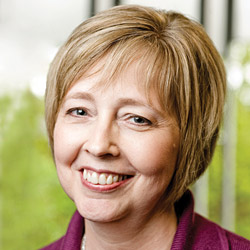From the Senior Editor
Seeking a Child's Open Creativity

What is art? What is great art, or is evaluating art entirely subjective? Can anyone be an artist, or just specially gifted people? What is the value of art to our lives and to the world?
Conversations about art often raise big questions — questions that could distract us from the joy of art itself. Perhaps, then, there was more than one good reason to put a baby on the cover of this Response.
Yes, Seattle Pacific University faculty member Ursula Krentz is conducting a research study about infants’ perceptions of beauty using abstract art as the reference point. It’s a fascinating story, and it’s in this issue. But the baby on the cover also reminds us that making and appreciating art requires what the late Madeleine L’Engle called “childlike openness.”
L’Engle was the author of more than 50 books of fiction, including the Newbery Medal winner, A Wrinkle in Time. She wrote in Walking on Water, her classic reflection on faith and art, that we make art “because we are listening for meaning, feeling for healing.” And when we write, paint, compose, sing, or play, “we are returned to that open creativity which was ours when we were children. We cannot be mature artists if we have lost the ability to believe which we had as children. An artist at work is in a condition of complete and total faith.”
I have the great privilege to work among artists every day. In my office at Seattle Pacific University, there are writers and designers who are also novelists, musicians, illustrators, a poet, and a film critic. It’s a creative environment that nurtures and sustains me.
We, in turn, are privileged to work on a campus filled with artists — some of them renowned — in every medium from painting to sculpture; poetry to nonfiction; stage design to acting. The arts journal Image makes its home here. Student and alumni artists create and display their work on campus and in Seattle and throughout the world.
In the midst of it all, faculty members facilitate a discussion of the relationship between art and faith, creator and Creator. They teach their students to immerse themselves in the big questions, in honest expression, and in beauty.
In this issue of Response, we invite you to engage with art for the first time, to re-engage with art, or to deepen a lifelong engagement with art. After all, says Eugene Peterson, the author of our annual featured book, The Pastor, the arts teach us ways of paying attention and new ways of understanding.
Says Peterson, “[Jesus] … never talked in terms of explaining. He was always using enigmatic stories and difficult metaphors. He was always pulling people into some kind of participation. It’s essential for us to develop an imagination that is participatory. Art is the primary way in which this happens.”
Jennifer Johnson Gilnett
